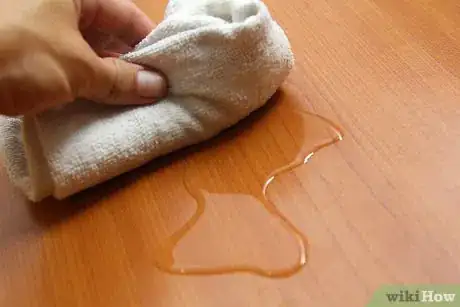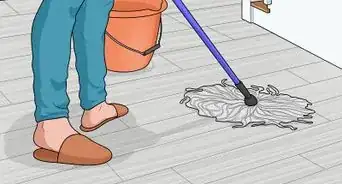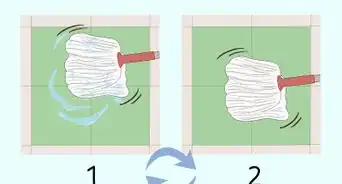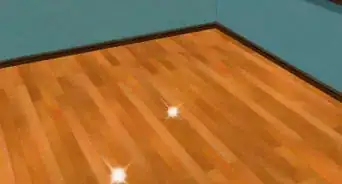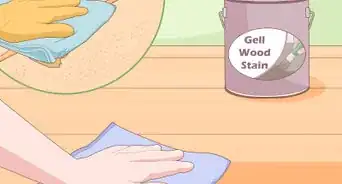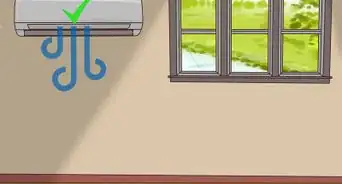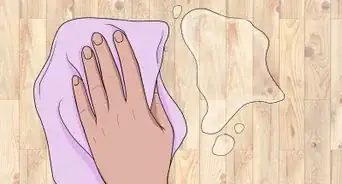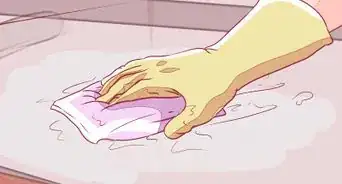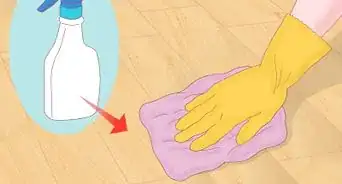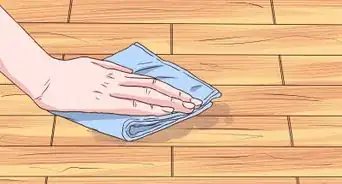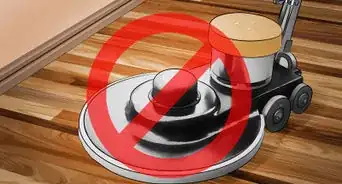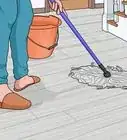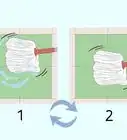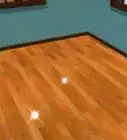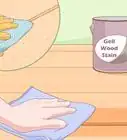This article was co-authored by Melissa Maker. Melissa Maker is host and editor of CleanMySpace, a YouTube channel and blog with over 1 million subscribers. She has over 10 years of professional cleaning experience, and dispenses helpful tips on all things home.
wikiHow marks an article as reader-approved once it receives enough positive feedback. In this case, 96% of readers who voted found the article helpful, earning it our reader-approved status.
This article has been viewed 1,024,504 times.
Cleaning something as valuable as hardwood can be intimidating, especially if you aren’t sure what the finish is. To clean your hardwood floor without damaging the finish, follow these steps. Patience and a little elbow grease are all you'll need to get nice, clean floors.
Steps
General Maintenance for Hardwood Floors
-
1Determine your kind of hardwood finish. Prefinished floors are the easiest to spot, as every board has beveled (slightly raised) edges. If the surface isn’t glossy, you have a stained or unfinished floor. Shiny floors are the most difficult to tell apart. To test your floor for wax, moisten extra-fine steel wool and rub it on an inconspicuous area; if a light gray smudge appears on the wool, you have a wax finish. To test whether you have an old or a modern surface seal, place a few drops of water on the most worn area of floor; if it remains beaded after several minutes, you probably have a modern seal, but if it seems to soak or darken the wood, you either have an older seal or a poorly-finished one that needs to be handled gently.
- Most new floors are surface-sealed with polyurethane, urethane, or a polyacrylic coating, all of which are water- and stain-resistant and therefore easy to clean.
- Older floors that haven’t been refinished usually have a shellac, lacquer, or varnish finish, and while these are technically also “surface-seals,” they aren’t nearly as durable as the more modern finishes; for the purposes of this article, they will, therefore, be placed under the “other” category alongside unfinished and waxed floors.
- Although prefinished floors are coated with a durable surface seal, the fact that each board is coated separately (as opposed to pressed up against one another on-site) means that the unsealed cracks between the boards are prone to water damage; for this reason, pre-finished floors also belong in the “other” category.
- When in doubt, choose the gentler method; a hardwood floor isn’t something you want to take chances with.
-
2Sweep the floor with a soft-bristled broom. This will remove large particles like sand or grit that may scratch the floor if caught beneath a mop. Alternatively, you can vacuum the floor, provided that the bristles are extended to prevent scratching and there is only dust on the floor.
- Also use the "bare floor" setting on your vacuum to prevent scratching the floor. Most vacuums have attached bristles to kick up dust, but these can ruin hardwood floors.
Advertisement -
3Stick to sweeping and mopping each week, only deep cleaning the floor as needed. While you should sweep and/or vacuum regularly to keep the floor free of dust and scratching agents, you should only clean your hardwood when it really needs it. This will prolong the life of your floor.
- Hardwood floors are generally easy to keep clean, as there is nothing to trap dirt or dust. A simple sweep or vacuum should cover most messes.
-
4Immediately wipe up any wet spills on hardwood floors. No matter what your finish, you should never leave moisture to sit around on hardwood floors. It can damage the seal and the wood permanently if you're not careful. Wipe it up with a damp cloth, then dry the surface completely.[1]
Cleaning Hardwood with a Modern Surface Seal
-
1Choose the right cleaning agent. For general cleaning, choose a pH-neutral ,water-based cleaner, like those designed for vinyl floors or hardwood-specific cleaners. To dissolve grease and dirt, choose an alkaline, water-based cleaner: soaps, detergents, or a bit of baking soda dissolved in water will do, though should be used sparingly. To dissolve hard water or mineral deposits, choose an acidic water-based cleaner; white vinegar or lemon juice in water would make a good rinsing agent to this effect.[2]
- Specific hardwood floor cleaners, of course, are your safest bet.
- Don’t use bleach, ammonia, abrasive cleaners, or anything that will leave a residue (ex. oil, furniture spray, wax). Not only will they damage the hardwood, but a few will even void the warranty on your floor.
-
2Dilute your chosen cleaning agent in a bucket of water. To avoid hard-water streaking, you may want to buy distilled water, which can be purchased cheaply at your local supermarket. However, a quick wipe down with a lemon juice and water mixture after cleaning will also prevent streaks, if hand dried afterwards.[3]
-
3Mop your floor with the chosen cleaning solution. Dip a mop into a bucket of your cleaning agent diluted in water. Run it over the floor along with the grain of the wood, starting in the farthest corner and working towards a door so you never have to step on wet floors. Refill the bucket if the solution gets too dirty.
- Remove your shoes. This will prevent you from marking or dirtying the floor while it’s wet.
-
4Spot-clean tough areas with a cloth. Dip the cloth in the cleaning solution and scrub it over stains with your hands to apply a more directed pressure.
-
5Use the mop to soak excess liquid off the floor. Replace the dirty water with fresh, clean water. Rinse and squeegee out the mop so that it is damp, and use it to pick up the dirty water left on the floor. Squeegee it into your clean bucket and repeat.
- Wring the mop dry, rub it over the wet floor until it’s saturated, and repeat until the floor is fairly dry. Do not postpone this step: though modern surface seals are water-resistant, they will not tolerate being wet for long periods. When you're done, rinse the mop and refill the bucket with plain water.
-
6Rinse the floor with the clean mop. This will remove any streaky or dulling traces of your cleaning solution.
-
7Buff the floor dry with terry cloth (optional). You can also use the wrung-mop method to dry the floor. This will prevent streaking and protect the life of your floor.
Cleaning All Other Hardwood
-
1Fill a bucket with water. To avoid hard-water streaking, you may want to buy distilled water, which can be purchased cheaply at your local supermarket.
-
2Remove your shoes. This will prevent you from marking or dirtying the floor while you clean.
-
3Dust the floor with a lightly dampened mop. Dip a mop into a bucket of water, wring it out completely and run it over the floor with the grain of the wood. As long as you can still wring water from the mop with your hands, it’s too damp to use. Wash the mop often during cleaning and refill the bucket if the water gets too dirty.
-
4Spot-clean tough areas with a cloth and a touch of odorless mineral spirits. Though they are too strong for regular use, mineral spirits can be a great way to remove stains like white water spots.
- Be sure to spot-test the mineral spirits on an inconspicuous area first. To do so, rub a small dot into the floor in an inconspicuous area (like under a couch). Return after 5-10 minutes to see if there is any damage to the floor.[4]
-
5Buff the floor dry with terry cloth (optional). Though this will give it a nice sheen, there should be almost no moisture on the floor, meaning you can also let it evaporate on its own.
Community Q&A
-
QuestionIf I have been using diluted vinegar with peppermint oil for cleaning, but recently haven't been able to remove the bare footprints from my floors, should I make a stronger vinegar solution?
 Community AnswerYou could try mild soap and water for just the footprints and then go back over with the vinegar/water.
Community AnswerYou could try mild soap and water for just the footprints and then go back over with the vinegar/water. -
QuestionCan I use a steam mop on hardwood floors?
 Community AnswerYes, it is the best for this purpose. However, it needs to be steam, not wet. Also ensure that it dries quickly. Obviously, do not leave wet or the floor will warp.
Community AnswerYes, it is the best for this purpose. However, it needs to be steam, not wet. Also ensure that it dries quickly. Obviously, do not leave wet or the floor will warp. -
QuestionHow do I get stains off an oiled hardwood oak floor?
 Community AnswerIf you are sure they are oiled, and refined (scent free) mineral spirits won't do it, it's possible that it is absorbed into the wood. If that is the case, then the stains can't be removed. You might be able to sand it away, but that's not a guarantee.
Community AnswerIf you are sure they are oiled, and refined (scent free) mineral spirits won't do it, it's possible that it is absorbed into the wood. If that is the case, then the stains can't be removed. You might be able to sand it away, but that's not a guarantee.
Warnings
- The two biggest enemies of hardwood flooring are scratches, which leave unsightly jagged lines across the wood grain, and water, which can cause your floors to warp and loosen over time. Avoid any cleaning methods that could introduce such elements to your floors.⧼thumbs_response⧽
References
- ↑ http://www.realsimple.com/home-organizing/cleaning/more-techniques/clean-hardwood-floors
- ↑ http://www.mnn.com/your-home/at-home/blogs/fact-or-fiction-fresh-lemon-removes-hard-water-stains
- ↑ http://www.mnn.com/your-home/at-home/blogs/fact-or-fiction-fresh-lemon-removes-hard-water-stains
- ↑ http://www.bhg.com/homekeeping/house-cleaning/surface/how-to-clean-hardwood-floors/
- https://www.youtube.com/watch?v=tZAD7Zt-s2c
- Wood Floor Doctor on cleaning hardwood floors
- This Old House on prefinished versus site-finished floors
About This Article
To clean hardwood floors, start by sweeping them with a soft-bristled broom or vacuuming them with the bare floor setting on your vacuum. Then, mop the floors using diluted white vinegar, diluted lemon juice, or a commercial hardwood floor cleaner. When you're done mopping, go over tough stains with a cloth and your cleaning solution. Finally, buff the hardwood floors with a terry cloth to get rid of any streak marks. To learn how to clean hardwood floors with a surface seal, keep reading!
